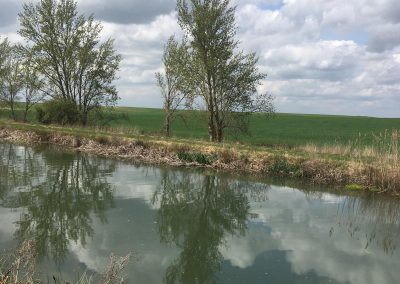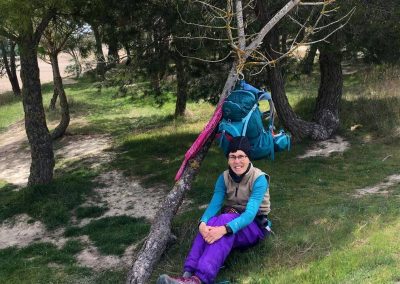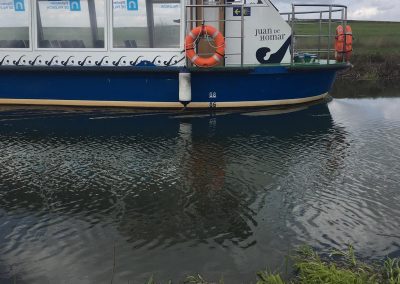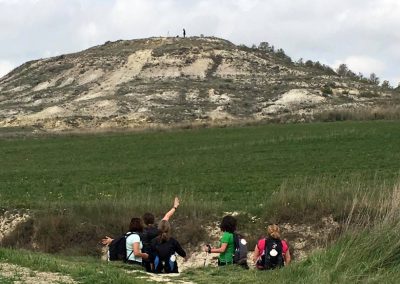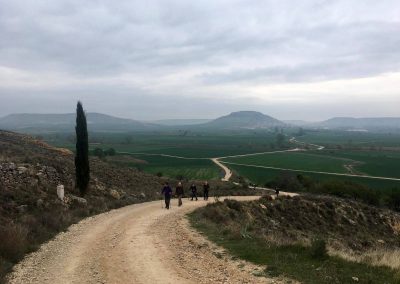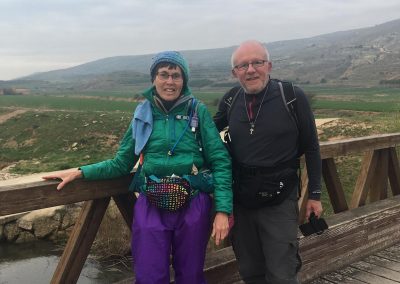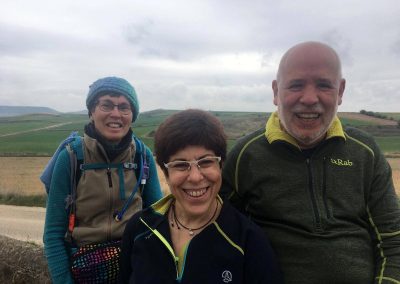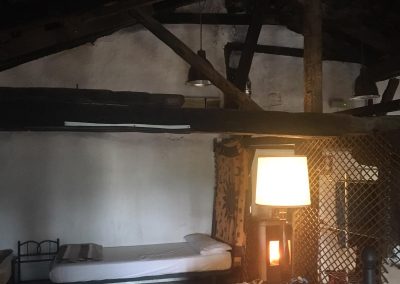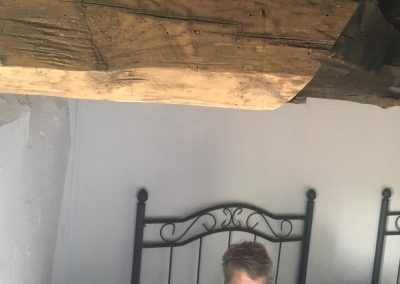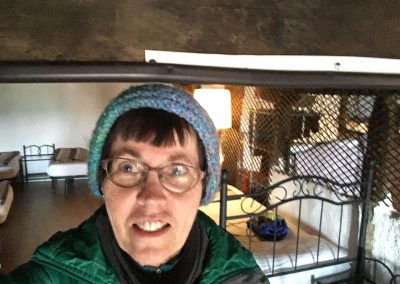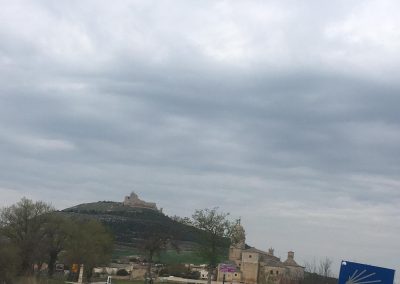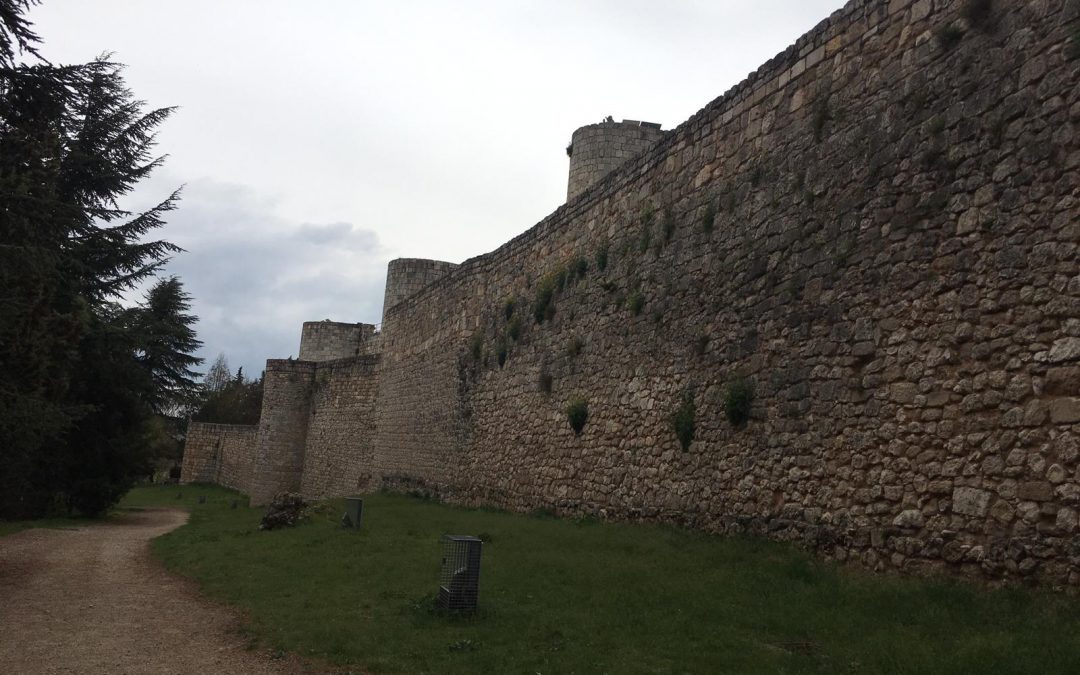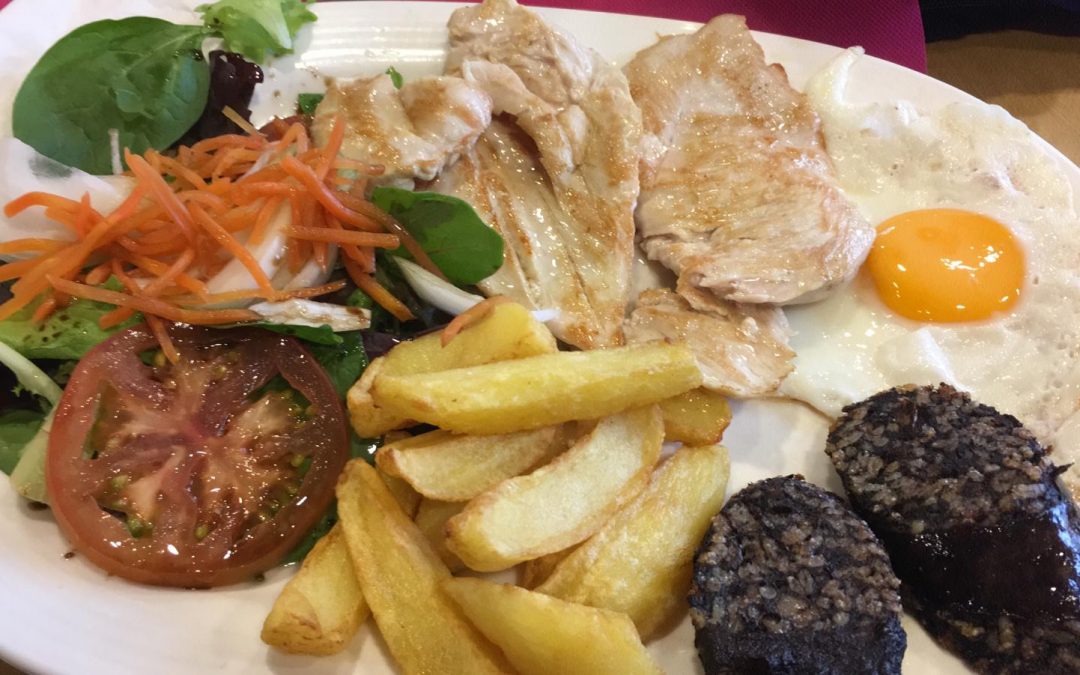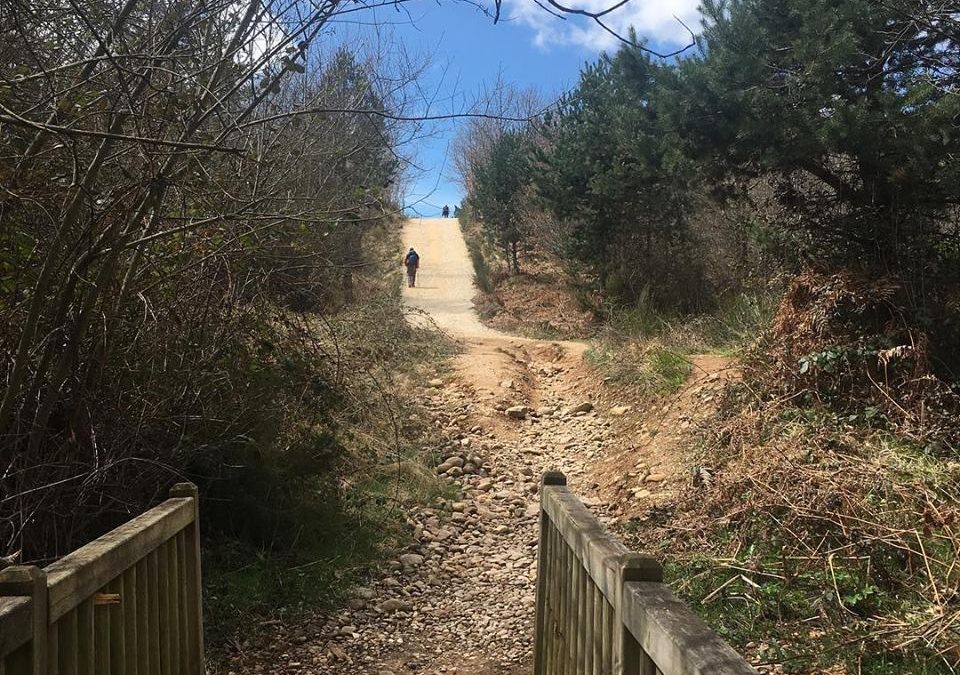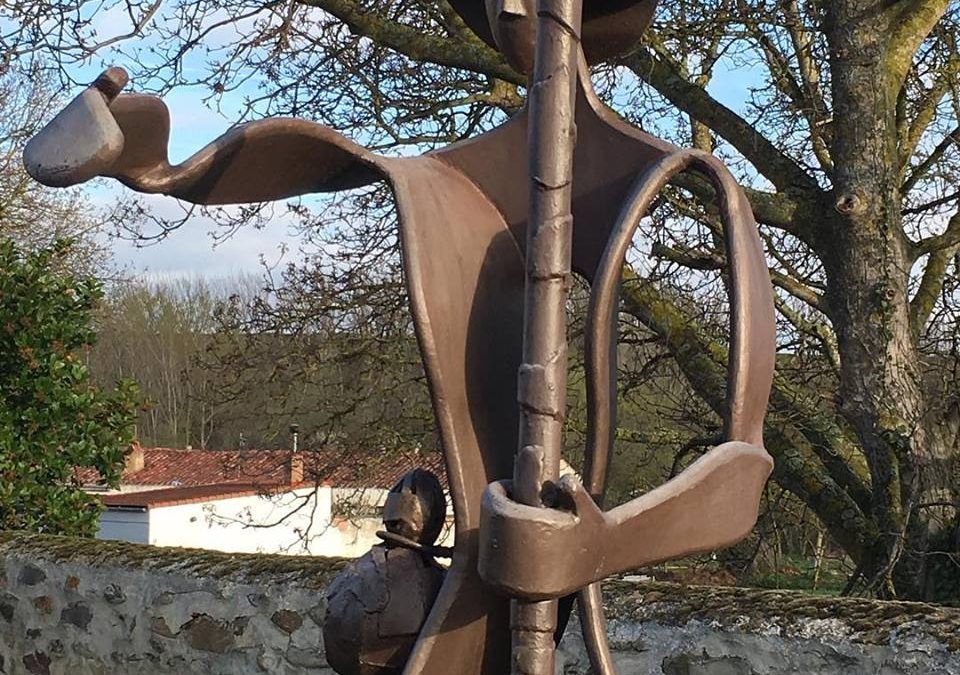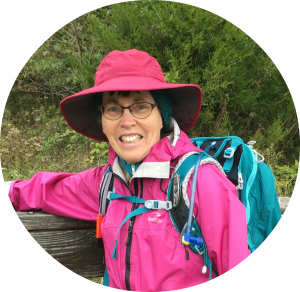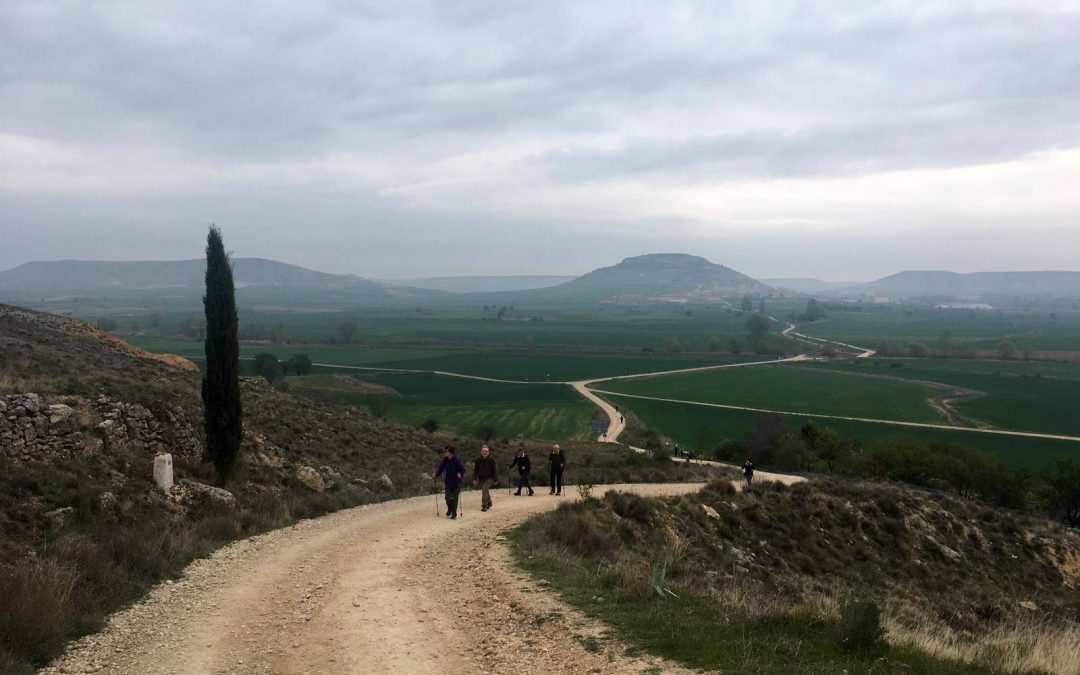
My road to Emmaus
Day 16, Easter Monday, April 22: Castrojeriz to Frómista (26.27 km, 16.3 miles)
(Note: I have not yet posted Day 15 [Easter, April 21]. I didn’t have time to do justice to two days this evening, and so I decided to capture this day while it was fresh. Stay tuned for the Easter report. )
But first, an update on the Pilgrim Trio, as of 6:00 pm on April 22:
- Barb: Wonder Woman that she is, she is half-way through the 24th “stage” of the Camino (our guidebook breaks the whole trek down to 33 days to Santiago. To give you some perspective, she is a good 8.5 “stages” or “etapas” ahead of me! She is upbeat in all her evening reports, is taking photos, meeting pilgrims, drinking in the beauty. Just for the record: there is absolutely no way on God’s good earth that I would have been able to keep up that pace. Out. Of. Question. So happy that Barb has found her pace and been able to maintain it, healthy in mind, body, spirit. You go, girl! (And if she hasn’t maintained those aspects to the extent that I think she has, then those are her stories to tell, not mine.) Barb is getting ever closer to the legendary O’Cebreiro where I’ve seen a forecast for 4 or 5 days in a row with some snowfall. Maybe she could try making an igloo and save a few euros on her nightly accommodations.
- Ginny: She might be having the most unique Camino experience of the three of us. I’d love to say that the knee problem/tendonitis was behind her. You can’t know how much I’d like to claim that. I have to limit myself to saying that the knee is better than it would be were she walking on it. Wisely–and because, really, there was no other choice while she was trying to heal–Ginny has done a bit of leapfrogging. Saturday morning she bussed ahead two “stages,” having her own experiences as she found bus stations, located her reserved albergue, got permission to stay two nights, was “hired” as assistant hospitalera to kind, English-speaking Javier. I met up with her on Sunday in time for the two of us to attend Easter services together. Again this morning she had another series of adventures taking a taxi to a town through which the León-bound bus would pass, then hopping onto it, stopping in the town I’ll reach tomorrow. She reports being escorted by helpful Spaniards who kissed her on both cheeks before she boarded the bus, and being given an emotional hug from a Korean she had met earlier, who, injured, was bussing even further down the line. One does what one can do…. I know you are all eagerly awaiting news of the two of us heading down the trail together again.
- Yours truly: “what doesn’t kill you makes you stronger,” so they say. My strength, apparently, is increasing, along with my love for the Camino. Still have a few tender toes, but nothing I can’t handle. (And, no, Kevin, I haven’t popped the blister between my big toe and the next one over. My technique is to cover them up and pretend that they aren’t there. If you can’t see them, they aren’t, right? My back muscles are being strengthened thanks to the pack; the core muscles surely are getting stronger as they are called into use very often to help me clear my nostrils. Remnants of that cold I caught early on. Hasn’t been too bothersome, but I’m ever grateful that Regina made me bring the large pink bandana. It is pinned–another great idea, those safety pins!–to my pack and called upon often. It is probably my most oft’- washed item on the trip. So, yes, I’m holding up quite well. Calling myself very lucky. I even seem to be getting used to the snoring that goes on around me. Are people really snoring less or I am just sleeping more soundly?
Ok, health and progress updates complete, I can’t wait to tell you about my walk to Emmaus!
Solitude? What solitude?
That’s what I told Ginny when I left Castrojeriz this morning, that I was looking forward to walking alone again today. There was lots of chatter at the long table at the breakfast buffet (corn flakes; packaged muffins which I heated in the microwave and the hostess acted like I had invented something brilliant; “would never have occurred to me,” she said; “I haven’t seen anyone else do that.” Huh? Surely I’m not the only one who prefers warm anything to room temperature!; biscuits to dip in the café con leche; orange juice). Yes, a lively group discussing which town each was walking to, which albergue they hoped to stay at, which we should avoid, etc., etc. I thought I was ready for some silence. I told Ginny of the few people for who my prayers were going to be directed.
And then…. then I started meeting people. Talking. Listening. Sharing the beautiful views together. I met:
- David Stott from England, from near to James Herriot country. We talked about Herriot and then discovered a lot of things we have in common. He, for one, not only had “business cards” printed out, but he brought his along on the Camino. So check out this photographer, scrapbooker, traveler, writer of poetry and journals and blogs at David’s story.weebly.com We parted company when one or the other of us stopped to take photos, but met up a few times along the way. He had along with him an actual photo album and I saw photos of his wife (deceased about a year now), his three daughters, his granddaughter whom he cares for 1.5 days/week. Very pleasant and engaging conversation.
- Neus and Jaume (from Barcelona, native speakers of Catalan). They were amazed to learn that I had studied Catalan in the US and that at one time I could speak and write it. Crossed paths with them at least three times today as we leap-frogged one another; along the way we find different reasons to stop
- Elaine and Bred (needs some kind of a diacritic so that the “e” is pronounced like the “e” of the word “eat” (one of my favorite things to do), sisters from Ireland (Limerick). I joined them on the porch of a cafe where I learned about them and told them about the counties from which my Daly, Hanley, Conley, and Dowd ancestors came from (Limerick being one of them). When I first connected with them, they were with three or four other Irish gals. “Were any of you on the Camino last April,” I asked of them, in, I’m afraid, my thickest brogue because I just can’t help myself! I’m supposed to be on the lookout for some women my friend Virginia walked with a year ago. “No, not us,” they assured me. And then we moved on, each one at our own pace.
- Karl from Germany. His English being as limited as my German (well, not quite…) we weren’t together for long.
- Raquel and Eduardo from Barcelona. They took my email and said they’d drop a note when they return home. Maybe during my post-Camino visit to Barcelona we might connect?
- And then, then the “find” of the day, a very precious hour or more alongside Jesús from Alicante (along the Spanish Mediterranean). He did the whole Camino 30 years ago when he was 30. (“Changed my life. I’ve been a different person since then,” he reported). Now he does trozos of the Camino–bits of it, a week one year, a week another–. He’ll finish this year’s section tomorrow. For him it has been mostly a silent week, he told me, but we clicked and I had my most enjoyable, deepest conversation of the Camino with him. Get this: he won the Premio Goya (Spanish equivalent of the Oscars) for his documentary film Sueños de sal in 2016 (I think). With the well-known filmmaker Carlos Saura–look him up: he rates next to Luis Buñuel and Pedro Almodóvar as one of Spain’s best-known filmmakers!–with Saura as one of his competitors! Wow, no? He has plans to redo the film (a full-length one, I think) to present in the 2022 Oscar “documentary shorts” category. But it wasn’t all that that got my attention, but rather his “feeling” for the Camino and his admission of some of the ways he had changed because of his very first pilgrimage. Our exchange became even more memorable when we stopped for an mid-afternoon break (coffee for him, orange juice for me) and he was telling me about an experience he had a couple of years ago. His mother’s death affected him greatly and he took a few months off to get his head screwed on straight. He recalled how he was walking on the beach one day when he saw a man sitting there, staring out at the ocean. This was in Algiers, down across from the Straight of Gibraltar. The muscular young man had only one leg. He saw him again the next day and talked with him. “I’m training to swim across to Africa,” the young man told him. Jesús had the opportunity to see him slip in the water and swim off with strong strokes. Training. It changed something in him. Lifted him from the fog he had been in. Made him realize how disabilities can be overcome with determination, etc., etc. That so much is just a matter of believing in oneself. But that’s not the story. The story is this: all of a sudden a 20-something male came around the corner. He had been working in the room next door, but he couldn’t help but hear the conversation and he came around to join us, showing us the stump at the end of his left arm. “Motorcycle accident,” he says. “But I haven’t let it hold me back. I’m an optimist. I wouldn’t let the fact that I’m missing a hand stop me from being all that I can be.” THEN the bar owner came in from whatever duties he had been performing and the conversation continued about the importance of the “cerebro,” the mind, by far the most valuable organ that we have. “If we have all our limbs and our health, but we aren’t using our minds, then we are nothing, have nothing.” …. Maybe you had to be there, but it was very powerful! I then shared about my friend Pam who did not let the fact that her MS left her paralyzed from the neck down keep her from being an inspiration to many with just her smile and her faith. Powerful time. With about an hour remaining in our day’s walk, I suggested that we not continue together, that we return to silence and attempt to process what we had experienced together. He stopped on the outskirts of the town where we’d stopped for the drinks, to meditate, and I walked on. We may or may not ever see each other again. Fine, either way. That’s how it goes on the Camino. The reunions are always joyous when they do occur.
Emmaus?
You remember, don’t you. The two disciples walking along, so distraught over Jesus’ death a few days earlier, so uncertain as to how to continue, thrown completely off course. And then this stranger, walking along the same roads, meets up with them and a conversation ensues. “And they recognized him [Jesus, the resurrected Jesus] in the breaking of the bread.”
So, from early on today, prompted, no doubt because it was, after all, the day after Easter, I found myself thinking of the road I was on as symbolic, as a road to Emmaus, where the strangers I was linking up with were somehow helping me interpret life. I had decided, almost from the get-go, that my post would have Emmaus in the title.
And the funny thing is, I had parted company with Jesús for well over an hour when it occurred to me to really take note of the fact that I had run into JESUS on my road to Emmaus! (I’m slow!). That realization tickled me.
Let me tell you what happened maybe fifteen minutes before my encounter with Jesús; this is appropriate for an Emmaus walk as well. I’m heading along on the near treeless meseta when I see a little copse on a little hillside. Cozy, refreshing, cool, easy to access… plus a good possibility to find cover and privacy for… well, you know what for! I climbed the rise, hung my backpack from a tree branch, took off my shoes and socks to apply more vaseline, and settled in to watch the pilgrims trudging up the path. When what do I hear? A long, loud, distant carcajada, a belly-deep …. “laugh” doesn’t really get the meaning across, but it’s the best I can do. What the heck? I look across to a distant hill, a kind of pyramid jutting up off the plain. It is not close to the trail, but atop it, unmistakable, is a pilgrim. Or a statue? A statue with a built-in speaker set to go off at intervals? All was still. No sound, no movement. Some other pilgrims coming up the trail stopped and looked. “It’s not moving”; their assessment concurred with mine. The form was stiff. Surely a wrought iron statue. All was quiet again. And then, another roar of a long carcajada, a slight movement. Arms rising to the sky, and holding.
I was fascinated. I watched him for at least 15 minutes, during which time there were several bursts of long-held laughter and a number of different body positions. Twenty minutes or so later, I noticed the lone pilgrim “merging” onto the trail again, maybe forty feet or so beyond where I was sitting.
So, folks, I figure there are several ways of interpreting this, and who’s going to say which one is the correct one? Was he laughing at how this world is just a thing of folly, signifying nothing? Laughing so as not to cry? Releasing something from down deep? And if a release, one that was very healing, joyful, reflecting some bit of self-discovery that had been long in coming? As I thought about it a good bit of the afternoon, I liked the version in which this was an enormous expression of Easter joy. The laugh was at Death and Meaninglessness of Life, all defeated when Jesus rose on Easter morn. The last laugh was not death’s, after all, but ours. Hey, it works for me. Emmaus! He lives!
As Jesús and I were leaving the bar, a tall young man with long hair and–I think!–a beard, huge pack on his back, entered the bar. Jesús, to whom I had talked about my “Emmaus day,” kidded: “Why, there’s your Jesus.” I wondered if there was any way that this might actually have been the “laugher on the mountaintop” (wasn’t that where Jesus liked to go to pray, to get away from people?). I was alone again on the trail and I walked slowly when I noticed that this tall, mysterious stranger was a ways behind me. When finally he caught up I asked him if perhaps he had been up on a high promontory earlier in the afternoon, laughing. “Not me,” he replied in English that was good but not native. “I’m just an ordinary person, trying to find my way in life.” He didn’t care to elaborate and I let him pass on without pressing him further. “An ordinary person, trying to find my way in life.” Aren’t we all?
And then there were these scenes
- Often I like to go into little stores just for a chance to interact a bit with the locals. I did so right off this morning as I was leaving Castrojeriz. Thinking it wouldn’t hurt to have some food along with me, I entered a very small and basic grocery store. I smile even now as I picture it. A tiny, tiny old woman came out from behind the curtain (or from behind the counter? She was so short I wouldn’t have seen her behind it!). I looked for something I might buy, and my eyes lit on an apple. Weight I didn’t need, but it sounded good, and I wanted to buy something. But then the problem of putting it somewhere. It’s such a chore to take off my pack once it is adjusted. Better idea still, and this is where my smile enters: I asked the woman if she might put it in my pack for me and I knelt down on the floor in front of her, attempting to describe which of the zippered pockets she should open in order to find a spot for the apple. A short interaction, but a sweet one. Wish I had a photo of it!
- In another little town through which the trail ran–a town with cute little dogs just doing their doggy strolls on the streets, no owners in sight–I got a good-sized chunk from a loaf of crusty bread, five slices of salami, and the same number of cheese slices. 1.3 euros which seemed shockingly little (just under $1.50 if you don’t factor in the price of the airline ticket…). This would make a fine lunch down the road.
- Said lunch I then forgot to eat until about 4:00 pm because I was either enjoying conversations with people or processing them when we parted company. It all worked out, though, because the trail hooked up with the Canal de Castilla, a canal built in the 18th century to help move the once-pulled boats filled with the meseta’s grain to market. It was beyond lovely, still full of water. Ah, the way the trees and clouds reflected in the still water was mesmerizing. I was in my glory. For the first time ever I could see myself doing a portion of the Camino on bicycle. I hadn’t read or heard about this canal, so it was a huge surprise to come upon it. I settled down for my picnic. I had barely put the sandwich together when off to my left I see… a good-sized excursion boat coming down the canal! My camera was already out to snap a photo of the sandwich spread out on my legs. You’d better believe that I caught some photos of the boat as well. Empty save for the boatman. Tourists on the canal? It was hard to picture. I have to wonder. Anyway, great sight. You would have loved it, no question. There was a reason why I had waited until 4:00 pm to sit down, fix my lunch, and take in the scene. I just didn’t know until then what that reason was.
- (Here allow me to vent: it’s a certain type of pilgrim who needs to read this, but if the shoe fits, wear it!). Ok, people, I understand that it is sometimes a long way between towns, especially on the meseta. I realize that you may need to irrigate or, lamentably, fertilize the soil from time to time, especially if you are hydrating as everyone says you must. But come on! Admittedly, there are few private spots and you are in a hurry. I understand that, too. But there is no excuse that I can think of for leaving your tissues behind. Please don’t! Pretty please! There are thousands of people trekking this Camino every year. You aren’t the type that would ditch a plastic bottle or even the wrapper from an energy bar. Think before you take off each morning; where are you going to put the soiled tissue to pack it out? You could think through all the logistics of how to get to the Camino. It can’t be that hard to figure out how to keep it pristine (even behind the bushes). ‘Nuf said!
- Today’s greatest challenge, and a warning to you to pay attention to your surroundings at all times. I found myself in one bathroom today (sorry, but there were no bushes in sight nor any large trees), the bowels a bit loose. I finish my business and, not spotting any toilet paper, remove a napkin from breakfast from my pants pocket and then… the lights go out. Not unusual. Happens all the time here; they seem very conscious about waste (of anything but bread and wine…). No problem. One just waves a hand a bit. Only today that didn’t work. Pitch dark, rather large bathroom, napkin in my hand. My phone–with a flashlight when one can work the screen properly, was on the floor somewhere, abandoned briefly while I… never mind….. Anyway, I did remember more or less where the door was and where the light switch was likely to be. Fortunately it was. All’s well that end’s well. I used to think it was sufficient upon entering a bathroom to make sure there was toilet paper available. Now, the paper, yes, but also be aware of where the light switch is. And remember to carry that napkin or paper towel in your pocket because your backpack with the toilet paper in a baggie is going to be outside on the sidewalk where it won’t do you one bit of good. End of that story.
- There are those who say the meseta is boring and monotonous. I couldn’t agree less. Today was so different from yesterday and especially the day before. Whereas my first encounter with it included a strong wind which made the grasses appear to be rippling wildly and racing “to the finish,” it couldn’t have been any more still and hushed than it was today, especially in the morning as we made our big climb out of Castrojeriz. For some the meseta is soul-draining, but I think for many it is the highlight of the trek where the largest amount of soul-searching takes place. It is, either way, a force to be reckoned with. For the next three days I’ll have a chance to reckon with it in the rain. We have yet to encounter a downpour on this trip. I would be happy to postpone that indefinitely. My feet aren’t eager for the rain and especially dread the resulting puddles and mud. Fingers crossed.
- Yes, though it was almost 5:00 pm when I arrived at this albergue, they had a bed available for me. Yes, a top bunk. Yes, as I finish this post, my roommates have been asleep for at least an hour if not more. But life is good: I have a blanket and, knock on wood, the snoring has ceased for the moment.
- Late lunch meant that i had no interest in the usual 7:00 or 7:30 dinner. My late afternoon included a shower, a bit of clothes washing and hanging, starting this post, going to the pharmacy, resuming writing. And then, as 9:00 pm approached, the realization that I was hungry. Maybe at least a bowl of soup. Heading down the hostel’s stairs I met a young Australian fellow who had been at the same albergue with me last night, a sweet 19-year-old who told me the restaurant just down the street had the best mushroom risotto he’d ever eaten. To die for. So off I rushed. Sat alone, but soon recognized the Catalans I’d met earlier in the day. They were just finishing up, however, so I ordered my risotto (first plate) and, for second plate: callos a la madrileña (“tripe” as cooked in Madrid). Oh, every 45 years or so a stomach deserves to eat some intestine, don’t you think? My time had come around again. The obligatory basket of bread, but what? Also a full bottle of wine for me? An excellent wifi so that I could actually send some photos and videos home (and I hear Regina has posted them on Facebook for me. Peter from Austria found his table partners leaving one by one, so he introduced himself and joined me (I’d invited him to help with the wine as I didn’t think it right to leave 5/6s of the bottle abandoned. The most memorable part of the story: feeling like Cinderella when I realized that I needed to scurry back across the street or my hostel’s entry would be locked tight for the night. Guess what my breakfast will be? Half of the risotto and tripe which the waitress boxed up for me. And my desert: an orange. I’ll have multiple reason to hop to it when that alarm goes off in the morning.
Quite the day!
Emmaus? Frómista? Bloomington? Chicago? Wherever you are, get out for a walk and see who or what you encounter on your road!

